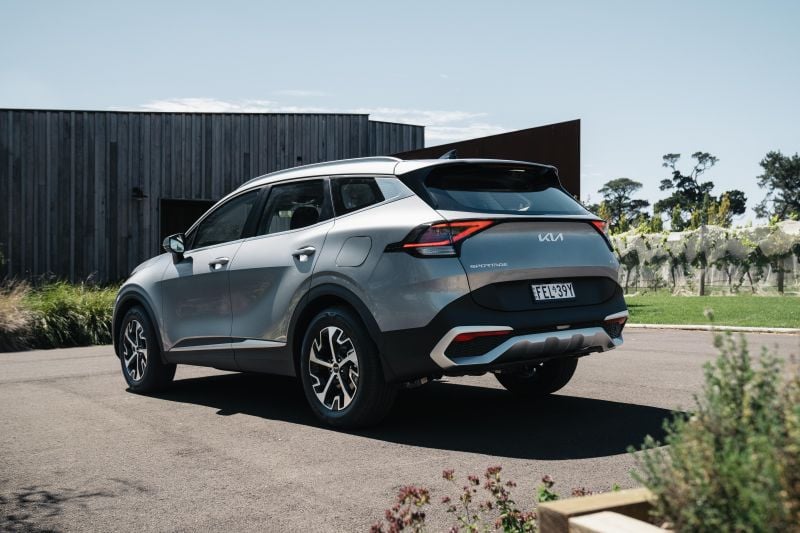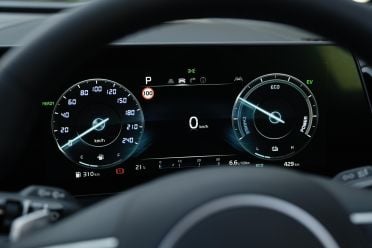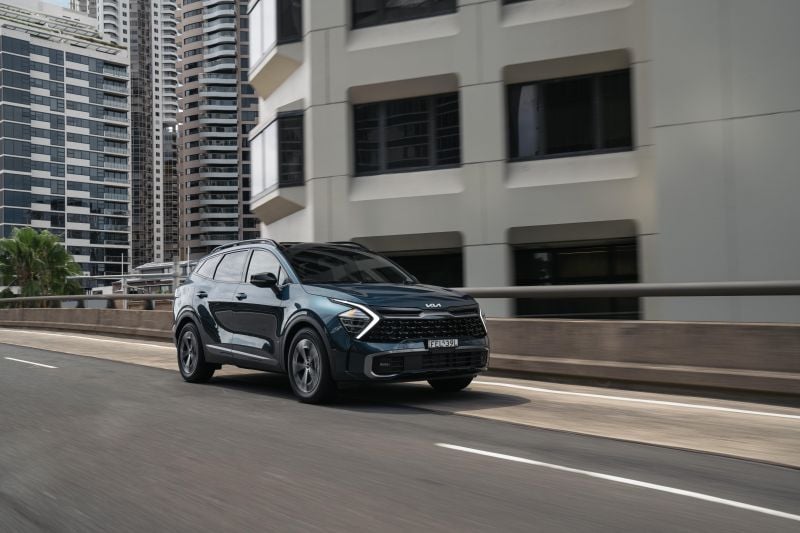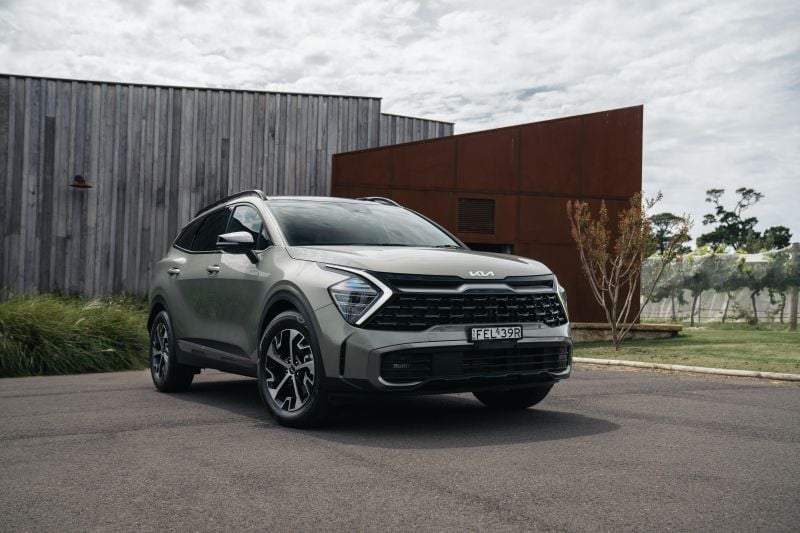Despite hybrids steadily gaining momentum in Australia in recent years, a lot of the mainstream brands have been quite late to the party – particularly in critical segments.
Note: This article is based off our most recent review of the Kia Sportage, as it has seen no major changes to pricing or specification since publication.
We have updated key details such as pricing and specifications with the most up to date information available. Read the latest price and specs article here for all the details.
WATCH: Paul”s video review of the 2024 Kia Sportage SX Hybrid
Take the top-selling mid-size SUV class for example; Toyota dominates with the RAV4 which is Australia’s favourite SUV, and the hybrid accounts for over 80 per cent of all RAV4 sales.
Still, competition in the segment has been limited to the GWM Haval H6 Hybrid, Subaru Forester Hybrid (more a mild-hybrid at that) and more recently the Honda CR-V and ZR-V e:HEVs; unless you count more expensive plug-in hybrids like the Mitsubishi Outlander and Cupra Formentor.
Now, Kia and Hyundai are finally coming to the table. Here on test we have the new Kia Sportage Hybrid, a critical new variant for the Korean brand that has been years in the making for Australia. It’s a car the CarExpert team receives enquires about to no end.
Hyundai has also committed to bringing the Tucson Hybrid as part of a mid-life facelift, though that’s not due to launch until June or July this year – so Kia has pipped its Korean parent in the race to bring hybrid to market.
It’s worth noting the Sportage Hybrid (HEV) will be supply limited at launch. Kia has locked in a monthly allocation of 300 units for the time being, which equates to about 20 per cent of the nameplate’s monthly volume in Australia.
Available in SX and GT-Line grades – but not S or SX+ trims – the Sportage HEV is also limited to front-wheel drive (FWD) only despite an all-wheel drive (AWD) option being available overseas and also offered by most rivals.
Should it be on your shopping list? Read on to find out.

How much does the Kia Sportage Hybrid cost?
The Sportage HEV range opens at $45,950 plus on-road costs for the SX, which is the variant we tested.
| Model | Price before on-road costs |
|---|---|
| S | |
| Kia Sportage S 2.0 FWD 6MT | $32,995 |
| Kia Sportage S 2.0 FWD 6AT | $34,995 |
| Kia Sportage S 2.0D AWD 8AT | $40,395 |
| SX | |
| Kia Sportage SX 2.0 FWD 6MT | $35,550 |
| Kia Sportage SX 2.0 FWD 6AT | $37,550 |
| Kia Sportage SX 2.0D AWD 8AT | $42,950 |
| Kia Sportage SX 1.6T HEV FWD 6AT | $45,950 |
| SX+ | |
| Kia Sportage SX+ 2.0 FWD 6AT | $42,950 |
| Kia Sportage SX+ 1.6T AWD 7DCT | $44,050 |
| Kia Sportage SX+ 2.0D AWD 8AT | $47,450 |
| GT-Line | |
| Kia Sportage GT-Line 1.6T AWD 7DCT | $49,920 |
| Kia Sportage GT-Line 2.0D AWD 8AT | $52,920 |
| Kia Sportage GT-Line 1.6T HEV FWD 6AT | $55,420 |
To see how the Sportage lines up against its rivals, check out our comparison tool.
What is the Kia Sportage Hybrid like on the inside?
It’s a pretty familiar place if you’ve ever sat in a current-gen Sportage, if for a few small distinguishing features.
You still get the swish 12.3-inch central touchscreen and funky touch control bar in the SX HEV much like petrol and diesel versions, as well as the ‘basic’ digital instrument cluster with clock radio-like tacho and speedo counters.
The main difference you’ll notice is the Sportage Hybrid picks up the rotary shift-by-wire selector in place of the traditional T-bar shifter you get in other lower-grade Sportages, much like the GT-Line models.
It’s otherwise very much the same. You don’t even see any distinguishing features in the instrument cluster bar an EV light when the vehicle is driving without the petrol engine running, and you get an additional widget in the 4.2-inch TFT supervision display which shows the energy flow between power sources.
The same can be said for the touchscreen, which offers high resolution and a snappy response like any other Sportage with this infotainment system. The differentiating factor is the additional ‘Hybrid’ sub-menu with energy flow graphics and hybrid-specific data.
It’s a shame there are no Kia Connect services or wireless smartphone mirroring, given this is slowly rolling out across Kia’s lineup; but it’s pretty logical to imagine these will be addressed with a forthcoming mid-life update, likely to launch in the next 12 months or so.
That’s not to say it doesn’t all work well. The native infotainment interface remains solid with its response and feature set good for the class. The digital instruments are very basic in the SX and the high-end 12.3-inch virtual cluster in the GT-Line looks nice but lacks the configurability of the VW Group stable.
I personally quite like the Sportage’s touch-capacitive control panel under the touchscreen, which does a convincing job at mimicking physical switchgear while also offering the ability to offer two main control panels in the one strip.
Unlike some other touch controls, these are pretty intuitive to use and save space in a way that won’t leave you pulling your hair out. That said, proper feedback like haptic vibrations would be nice, rather than beeps.
Comfort up front is good in the cloth-trimmed SX we tested, with plenty of manual adjustment in the seat and steering wheel to find a comfortable driving position for my 6’1 frame.
The GT-Line features heated and ventilated front pews, which are also electrically adjustable with memory presets for the driver – quite posh. If you get cold hands in winter, the GT-Line HEV’s exclusive heated steering wheel is a nice touch too.
If you go for the SX there’s just blank buttons where those controls would be, and the lashings of piano black trim are fingerprint-prone given the high-traffic nature of the centre console. It otherwise presents quite nicely even in the lower specification.
Storage is pretty good too, with a lidded cubby under the infotainment system for your phone – though you may struggle to fit a plus-sized phone when plugged into Apple CarPlay or Android Auto – and there’s a modular centre console with two cupholders and extra storage space around them.
A deep bin under the padded centre armrest adds further storage volume, though the door pockets could be larger. The latter is a complaint I’ve leveraged at just about every Hyundai and Kia product on this latest large car platform.
The second row is another Sportage highlight, with one of the most spacious rear benches in class.
Two adults will be more than happy in the rear, while the flat bench and floor means three will fit across without too much trouble for shorter journeys – I tried it with friends and got few complaints.
Amenities in the SX include a fold-down armrest with cupholders, directional air vents, map pockets behind both front seats, bottle holders in the doors, as well as your requisite top tether and ISOFIX points.
If you step up to the GT-Line, you add bag and jacket hooks behind the front headrests and on the seatbacks, as well as USB-A charge ports on the inner sides of each front seat. No extra zone of climate though…
Kia hasn’t detailed any discrepancies in the boot compared to other Sportage variants, meaning the HEV retains the spacious 543L boot (VDA) which expands to a big ol’ 1829 litres with the second row folded.
There’s still space to stow the cargo blind under the boot floor if you need to carry taller items, and the Sportage HEV still offers a space saver spare under the boot floor. While the RAV4 Hybrid also offers a space saver spare, a lot of electrified rivals are only fitted with tyre repair kits.
| Dimensions | Kia Sportage Hybrid |
|---|---|
| Length | 4660mm |
| Width | 1865mm |
| Height | 1665-1680mm |
| Wheelbase | 2755mm |
| Cargo capacity | 543-1829 litres |
To see how the Sportage lines up against its rivals, check out our comparison tool.
What’s under the bonnet?
The Sportage Hybrid draws upon the same turbocharged drivetrain as the larger Sorento Hybrid.
| Specifications | Kia Sportage HEV |
|---|---|
| Engine | 1.6L 4cyl turbo |
| Engine power | 132kW (5500rpm) |
| Engine torque | 265Nm (1500-4500rpm) |
| Electric motor power | 44kW |
| Electric motor torque | 264Nm |
| Total system power | 169kW |
| Total system torque | 350Nm |
| Battery pack | 1.49kWh |
| Driven wheels | Front-wheel drive |
| Weight | 1738kg (kerb) |
| Fuel economy | 4.9L/100km |
| Fuel economy (as tested) | 6.5L/100km |
| Minimum fuel requirement | 91 RON |
| CO2 emissions | 110g/km |
| Emissions standard | Euro 5 |
| Braked tow capacity | 1650kg – braked |
It’s worth noting our indicated fuel economy figure was achieved over 900km of mostly freeway and highway driving, including a return trip to Echuca over the Easter long weekend.
We did see in mid-5L/100km in shorter-term readouts with more city and urban driving thrown in – more representative of most people’s daily commutes.
To see how the Sportage lines up against its rivals, check out our comparison tool.
How does the Kia Sportage Hybrid drive?
If you already liked how the Sportage drives, the hybrid does little to change an already winning formula.
With a more powerful electric motor and larger hybrid battery than rivals like the Toyota RAV4 and Subaru Forester, the Sportage has the capability to drive in electric mode more often, and for longer. That’s despite not actually having an EV Mode button like many other hybrid offerings do.
But while it has the capability to do this, it doesn’t always do this. This is likely what contributed to the consumption figure that was a bit higher than the claim, despite the Sportage often kicking into EV mode at speeds its Japanese rivals rarely would.
There were occasions I would accelerate from a standstill to 60-70km/h at reasonable pace without the petrol engine firing, and others where almost immediately after pressing the throttle the 1.6-litre turbo would turn on to assist. It seemed the Sportage HEV liked to keep its battery between 50 and 75 per cent charged where it could.
During my trip to Echuca the Sportage would also slip into EV mode at up to 110km/h an hour, and even maintain speed on slight inclines if it felt like it. That said, the fuel consumption readout would hover around 6.0-6.5L/100km at these higher speeds.
Kia’s approach to hybrid differs a little to the setups employed by rival manufacturers. The electric motor is mounted to the six-speed automatic transmission, as opposed to driving through a hybrid transmission module or e-CVT.
This means you can actually feel the Sportage shuffle through ratios regardless of whether you’re using the electric motor, petrol engine, or both at times. It’s perhaps less pronounced here than it is in the smaller Niro Hybrid, though it can feel a little odd on occasion when you feel the Sportage kick down while in EV mode.
Performance is actually quite strong, and the handover between e-power and the turbocharged petrol engine is pretty seamless as both power sources produce very similar peak torque levels – and the 1.6 T-GDI develops peak torque as low as 1500rpm.
While there’s minimal vibration or kickback when the petrol engine does fire to life, the turbo petrol motor does make its presence known with a distinctively buzzy note when running, and it generally will come in at high revs. It’ll quickly spin to 2000rpm when it first turns on, and often won’t shift up until about 3000rpm.
In fairness it’s not like a RAV4 Hybrid is any less coarse under load, neither the GWM Haval H6 HEV. But, in a time where all-electric rivals produce little-to-no noise at all times, it could be an area of improvement moving forward.
Call on all 169kW and 350Nm, and the Sportage HEV gets up and goes with gusto. I did a few overtakes on the country highways heading towards Echuca, and I noticed the Kia had a surprising amount of pep given its efficiency bent.
As a guide, the UK-spec Sportage HEV – which is slightly smaller than the Australian version – quotes an 8.4s 0-100km/h time which is matched by the UK-spec RAV4. That said, the RAV4’s weaker naturally aspirated petrol engine and less torquey electric motor don’t offer as strong a response at higher speeds.
It’s just a shame the Sportage HEV doesn’t have an extra gear or two. In sixth it’ll settle around 1800-2000rpm at 100-110km/h, which is fine but not quite as relaxed as some CVT-equipped hybrids nor its ICE siblings. If you’re touring more often than not, the Sportage 2.0D will be more relaxed and more economical.
Like petrol and diesel models, the Sportage HEV gets a local ride and handling tune to optimise its performance on Australian roads, and it shows.
And, as we’ve found with the wider range, the Sportage strikes a very nice balance between overall comfort as well as handling precision, to the point where it’s one of the segment benchmarks.
The accurate steering tune means it goes where you point the wheel and also gives you a decent level of feedback, with a lighter weight to make lower speed manoeuvres a cinch.
As the speed climbs there’s a nice solidity about centre and there’s a nice big-car feel to the road holding which inspires confidence on patchy roads and in inclement weather. Benefits of being based on a larger platform rather than a smaller one, methinks…
As for assistance systems, it’s pretty much the same as previous reviews of the Sportage. Given Kia hasn’t subjected the Sportage to a mid-life update yet, it’s devoid of those infuriating speed limit warnings that are plaguing the latest Hyundai and Kia products.
The adaptive cruise control system works well, and you can use Lane Following Assist to facilitate semi-autonomous highway driving in lieu of the company’s rather impressive Highway Driving Assist that’s available abroad.
If the lane centring function is a little too much for you, there’s standard lane departure warning and lane keep assist functions to keep you within the lines, and Kia fits blind-spot and rear cross-traffic assists which will actively intervene to avoid a collision, rather than just sounding an audible warning.
What do you get?
The Sportage HEV is available in SX and GT-Line trim levels, and largely mirrors the specification of existing petrol and diesel equivalents.
Sportage SX HEV highlights:
- 18-inch alloy wheels
- Auto LED reflector-type headlights
- Auto high-beam
- Rain-sensing wipers
- Power-folding exterior mirrors
- 12.3-inch touchscreen infotainment system
- Wired Apple CarPlay, Android Auto
- Satellite navigation
- ‘Basic’ digital instrument cluster with 4.2-inch screen
- 6-speaker audio
- Cloth upholstery
- Leather-appointed steering wheel
- Dual-zone climate control
- Electronic parking brake with auto hold
- Space-saver spare wheel
- Dial-type shift-by-wire selector
Sportage GT-Line HEV adds:
- LED projector-type headlights
- Full LED tail lights
- Leather upholstery
- Keyless entry, start
- Electrochromic rear-view mirror
- Hands-free power tailgate
- Wireless phone charger
- 64-colour ambient lighting
- 8-speaker Harman Kardon premium audio
- 12.3-inch digital instrument cluster
- 8-way power driver’s seat, 2-way power lumbar
- 8-way power passenger seat
- Heated, ventilated front seats
- Heated steering wheel
- Panoramic sunroof
- Rear privacy glass
- Alloy sports pedals
Is the Kia Sportage Hybrid safe?
All versions of the Kia Sportage wear a five-star ANCAP safety rating, based on Euro NCAP testing from 2022.
| Category | Kia Sportage |
|---|---|
| Adult occupant protection | 87 per cent |
| Child occupant protection | 87 per cent |
| Vulnerable road user protection | 66 per cent |
| Safety assist | 74 per cent |
It’s worth noting the European-spec Sportage differs a bit from the vehicle sold in Australia and New Zealand, and ANCAP acknowledges that additional data supplied by Kia shows that equivalent performance can be expected for local versions.
Standard safety equipment includes:
- Autonomous emergency braking (AEB)
- Vehicle, Pedestrian, Cyclist detection
- Junction assist
- Blind-spot assist
- Driver attention alert
- Intelligent speed limit assist
- Lane Following Assist (lane centring)
- Lane keep assist
- Parking sensors front, rear
- Rear cross-traffic assist
- Reversing camera
- Safe Exit Warning
- Tyre pressure monitoring
GT-Line adds:
How much does the Kia Sportage Hybrid cost to run?
Kia covers its lineup with a seven-year, unlimited-kilometre new car warranty. For electrified products like the Sportage HEV, high-voltage components like the on-board charger, electric motor and battery system are covered for seven years or 150,000 kilometres – whichever comes first.
| Running costs | Kia Sportage Hybrid |
|---|---|
| Warranty | 7 years, unlimited kilometres – vehicle 7 years or 150,000 kilometres – HEV components |
| Roadside assistance | Up to 8 years |
| Service intervals | 12 months or 10,000km |
| Capped-price servicing | Up to 7 years |
| Total capped-price service cost | $4502 – 7 years |
It appears the Sportage HEV is the priciest engine variant to service, and Kia continues to charge above average amounts for capped-price servicing.
For reference, Hyundai offers a five-year pre-paid service plan for the Santa Fe Hybrid which uses an identical drivetrain for $2295 – nearly $700 less than what Kia charges over the same period for the Sportage HEV.
To see how the Sportage lines up against its rivals, check out our comparison tool.
CarExpert’s Take on the Kia Sportage Hybrid
If it wasn’t handicapped by supply, I think the Sportage HEV could catapult the Korean SUV into contention for segment leadership on the VFACTS sales charts.
The latest Sportage has been widely praised for its combination of value, practicality and on-road refinement; and this new hybrid version only adds to that thanks to its frugal and in-vogue electrified drivetrain.
It may not be as outright efficient as a RAV4 Hybrid or even the GWM H6 Hybrid, but the Sportage HEV offers better driving performance, better infotainment technology and a more upmarket feel than both of its aforementioned rivals.
Areas for improvement? A price-leading variant below $40,000 would be nice to have, and the monthly cap of 300 units likely means it won’t be long until wait times blow out much like we saw with the larger Sorento Hybrid. It’s also very expensive to service over the long term, and buyers wanting all-paw traction need to look elsewhere.
Perhaps the Sportage’s biggest threat comes from within its own family tree, as the upcoming Hyundai Tucson Hybrid should be less affected by supply constraints and will offer a wider range of variants when it arrives mid-year – including the option of all-wheel drive.
The facelifted Tucson will also bring with it newer tech not currently offered by the Kia, including the excellent new ccNC infotainment interface, connected services, and the latest suite of Hyundai-Kia assistance systems. We’re betting that Hyundai will also regulate ongoing maintenance costs better than Kia, too.
Until then, though, the Kia Sportage HEV offers a great alternative to existing hybrid staples in Australia’s most competitive new vehicle segment, and also finally gives prospective Sportage owners an electrified option. I have no doubt that Kia Australia will sell every one it can get, if current market trends are a guide.
Interested in buying a Kia Sportage? Get in touch with one of CarExpert’s trusted dealers here
Click the images for the full gallery
MORE: Everything Kia Sportage






































